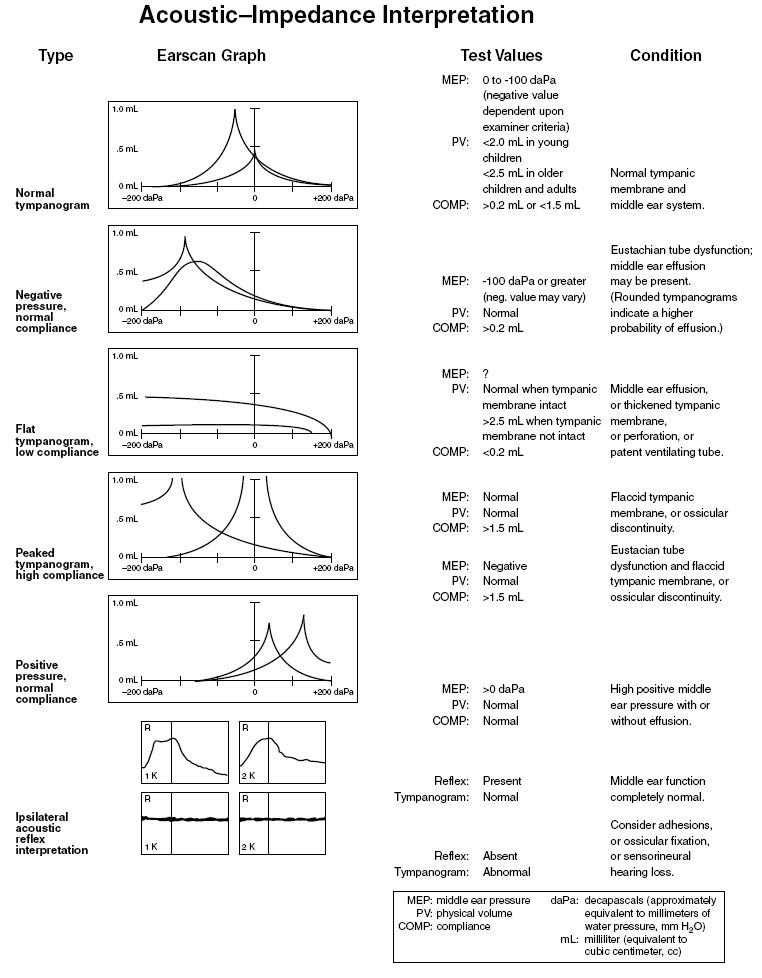Nejm 1995;332:1560; Am J Publ Hlth 1977;67:472
Cause:
Acute: 75% are bacterial (Jama 1994;273:1598): H. flu (25%), 40% are  -lactamase pos, if associated w conjunctivitis, then 70% are H. flu non-
-lactamase pos, if associated w conjunctivitis, then 70% are H. flu non- -lactamase types; pneumococcus (35%); Moraxella (Branhamella) catarrhalis(25%); other strep; viral (30%) (Clin Ped 1972;11:204), although more (40%) may be viral induced (Nejm 1999;340:260), RSV, parainfluenza, and influenza
-lactamase types; pneumococcus (35%); Moraxella (Branhamella) catarrhalis(25%); other strep; viral (30%) (Clin Ped 1972;11:204), although more (40%) may be viral induced (Nejm 1999;340:260), RSV, parainfluenza, and influenza
Chronic: above plus staph, proteus, pseudomonas
Serous type (chronic OM w effusion): fluid secretion without culturable organisms usually, although 1/3 may have organisms (Jama 1998;279:296)
Significant genetic predisposition by twin studies (Jama 1999;282:2125, 2167)
Pathophys:Rhinitis and sinusitis spread along eustachian tube. Cmplc's from juxtaposition of several structures, eg, meninges, facial nerve, oval and round windows, semicircular canals, and lateral sinus. Allergic/atopic individuals have much higher persistent rates (D. Hurst, Otolaryngol-Head Neck Surg 2000;123:533; Laryngoscope 1999;109:471). Chronic recurrent infections from organisms imbedded in biofilms on or inside TM (Jama 2006;296:202)
Some viral infections predispose, eg, RSV, influenza, and adeno (Nejm 1982;306:1377).
Serous OM often follows infectious resolution and correlates w socioeconomic status; smoking effect
Sx:Pain, severe and deep, unbothered by external ear manipulation, may improve suddenly w spontaneous drainage; sense of fullness; diminished hearing acuity
Si:Decreased hearing; inflamed drum often bulging; loss of light reflex, poor air movement and pain w pneumatic otoscopy
Acute usually improves within 48 h of starting antibiotics, and clears in <2 wk.
Serous OM is persistent OM w effusion which lasts >3 mo w hearing loss
Lab:Parents unreliable as diagnosticians (Peds 2010;125:e1154)
Tympanometry (Fig 4.1) to evaluate middle ear effusions (Nejm 1982;307:1074); not helpful <age 6 mo
Figure 4.1 Tympanogram Interpretation.

Reproduced with permission from Micro Audiometrics Corp.
Xray:CT of mastoids show haziness early, sclerosis and erosion later
Rx:Prevent w
- Pneumococcal vaccine conjugated at age 2, 4, 6, and 12 mo, decr overall incid by 6%, vaccine type pneumococcal episodes by 20% (NNT-2 = 5) (Nejm 2001;344:403)
- Prophylactic antibiotics, rarely used now: sulfisoxazole, or amoxicillin, or Tm/S all at half rx doses as single hs dose × 3 mo or with URIs (Med Let 1983;25:102); as good as tubes
- Influenza vaccines do not decr incidence (Jama 2003;290:1608)
of acute OM (see management flow chart—Nejm 1995;332:1560): antibiotics, 1st, amoxicillin 40 mg/kg/d, or 60-90 mg/kg/d if pcn-resistant pneumococcus possible; 2nd, amoxicillin/clavulinic acid (Augmentin); 3rd, Tm/S (8/40 kg/24 h) in 2 doses; 4th, erythromycin + sulfa (Pediazole); 5th, cefaclor, et al. Or, if won't take po, ceftriaxone 50 mg/kg im up to 1 gm × 1, may dilute w lidocaine to decr pain (Rx Let 1998;5:10). 5 d rx may be enough over age 2 yr. Could give rx and tell to fill if not better on Tylenol in 48 h since only <1/7 cases, over age 2 yr and otherwise low risk, will need antibiotics and benefit at 2 wk no different than placebo (Jama 2006;296:1235; BMJ 2000;320:350); an especially good strategy if TM not bulging since most of these are viral (Nejm 2002;347:1169)
of serous OM: antibiotics may help clear (~1/3 over 1 mo after 2 wk rx), but many will clear spontaneously (Nejm 1987;316:432); steroids × 7-14 d with antibiotics (Arch Otolaryngol Head Neck Surg 1991;117:984)
Decongestants and antihistamines no help in acute or serous (BMJ 1983;287:654; Nejm 1983;308:297) though many practitioners still feel they help
Surgical: tubes help hearing acuity, but not verbal/intellectual losses (Nejm 2005;353:576; 2001;344:1179; 1985;312:1529) or long-term outcomes (Paradis Nejm 2007;356:248); polyp and granulation tissue removal; prosthetic replacement for ossicle necrosis. Mastoiditis can be rx’d with simple mastoidectomy, mastoid tympanoplasty, or radical mastoidectomy if advanced. Adenoidectomy may help serous OM esp w tubes (Nejm 2001;344:1188; 1987;317:1444; Jama 1999;282:945 vs 987)
 -lactamase pos, if associated w conjunctivitis, then 70% are H. flu non-
-lactamase pos, if associated w conjunctivitis, then 70% are H. flu non- -lactamase types; pneumococcus (35%); Moraxella (Branhamella) catarrhalis(25%); other strep; viral (30%) (Clin Ped 1972;11:204), although more (40%) may be viral induced (Nejm 1999;340:260), RSV, parainfluenza, and influenza
-lactamase types; pneumococcus (35%); Moraxella (Branhamella) catarrhalis(25%); other strep; viral (30%) (Clin Ped 1972;11:204), although more (40%) may be viral induced (Nejm 1999;340:260), RSV, parainfluenza, and influenza